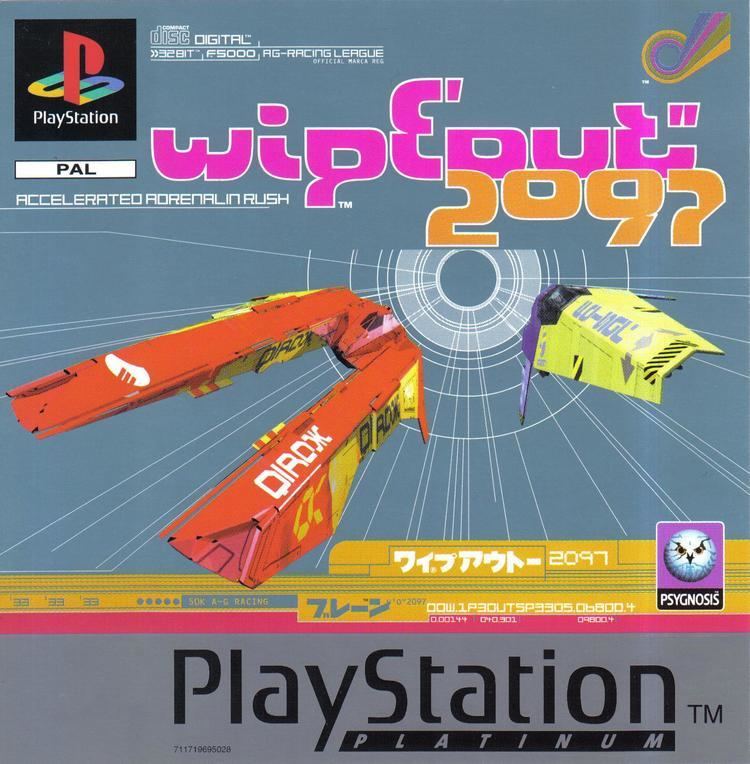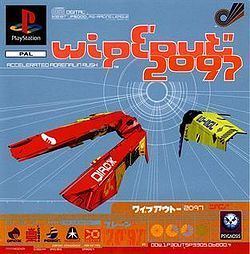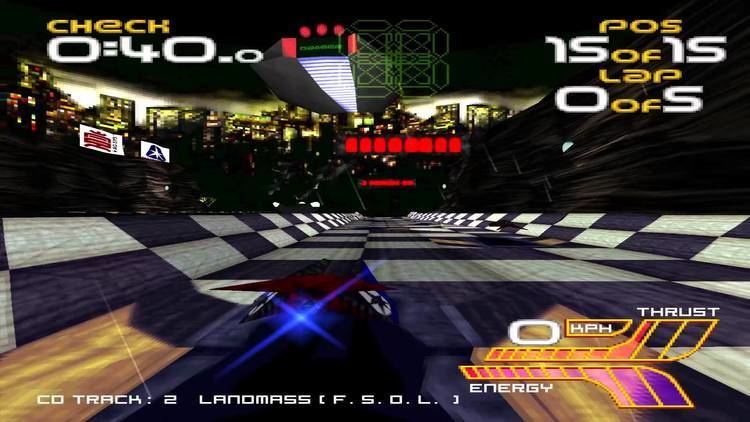9.2 /10 1 Votes
Initial release date 30 September 1996 | 4.6/5 Emuparadise Genre(s) Racing Series Wipeout | |||||||||||||||||||||||||||||||||
 | ||||||||||||||||||||||||||||||||||
Programmer(s) Stewart Sockett, Chris Roberts, Nick Kimberley Artist(s) Pol Sigerson, Ashley Sanders, Nicky Westcott, Dave Crook, John Harris, Eve Penford, Darren Douglas, Jeff Bramfitt, Mick Harrison Mode(s) Single player, two-player (via PlayStation Link Cable), multiplayer (via IPX, TCP/IP, modem, or null modem) Similar Wipeout games, Psygnosis games, Racing video games | ||||||||||||||||||||||||||||||||||
Wipeout 2097 (stylised wipE'out"2097; released as Wipeout XL in North America) is a 1996 futuristic racing game developed and published by Psygnosis. It is the second instalment released in the Wipeout series, and is the direct sequel of the original game released the previous year. It was originally released in 1996 for the PlayStation and Microsoft Windows, and in 1997 for the Sega Saturn. It was later ported by Digital Images to the Amiga in 1999 and by Coderus to Mac OS in 2002.
Contents

Whereas the original game introduced the F3600 anti-gravity racing league in 2052, Wipeout 2097 is set over four decades later and introduces the player to the much faster, more competitive, and more dangerous F5000 AG racing league. The game introduced a new damage interface and new weapons and tracks. The Sega Saturn version supported analogue control by using its 3D Control Pad, whereas the PlayStation version supported analogue control only through using the optional Negcon twist controller.
The game received generally positive reviews from critics, who praised the game for its unique blend of trance music and designer logos and cited that Wipeout 2097 was the beginning of a new trend in gaming to tap into popular culture and other arts. IGN ranked the game as the 13th best PlayStation game of all time in 2002.

Wipeout 2097 gameplay psx ps1 ps one hd 720p epsxe
Gameplay

Gameplay did not differ much from the previous title. Aside from the different circuits and new weapons, the fundamental aspects were kept. Pilots would race each other or computer-controlled A.I. opponents, to finish in the highest position possible. To help them achieve this end, weapons were provided.
Though the crafts move at very high straight-line speeds, Wipeout takes its inspiration from Formula 1 breakthroughs by aspiring for even greater turning speeds. Using the Formula 1 parallel, rather than using aerodynamics to increase wheel grip by down-force for faster turning speeds, Wipeout uses a fictionalised method of air braking for ever greater turning force. Just moving a craft left or right alone is very responsive, but by applying an air-brake in the direction of movement, players zip around very tight turns at near top speed, including those greater than 90 degrees. By applying an air-brake, the turn starts out gradually but as it continues, change in direction increases sharply. Where necessary, the player may also use dual air-brakes for rapid deceleration, typically used if the pilot has flown off the racing line in tight corners and needs to steady. The player can also take on damage from enemy fire and be blown up, but the ship can be "recharged" to health at the pit stop in exchange for a precious few seconds of the race.
Aside from the usual tactical aspects of racing, Wipeout 2097 (unlike its predecessor) offered the chance to eliminate other players from the competition through the use of weapons. Each craft had a shield energy quota, and when this quota reached zero—either from damage sustained from weapon attacks, or impact from other craft or the edges of the circuit—the craft would blow up. The craft would also blow up if a certain time limit was not reached, though this only applied to human players. The biggest weapon introduced in 2097 was the Quake Disruptor, which has been a series hallmark ever since. This weapon cause a quake to thrust a destructive wave down the track that dunks the crafts it smash into.
The aim of the game remains the same from its predecessor; complete various and increasingly difficult challenges to move on to the next race. Changing the difficulty level is simply that of upping the top speed of the craft, through four different classes (Vector, Venom, Rapier and Phantom). The number of laps needed to complete a race also increased with each new class. Victory in the challenge modes was the game's ultimate accomplishment. These modes are similar to a championship where players have to race every track to become champion; however, rather than tallying up points, Challenge mode took a very single player-centric approach by only allowing progress to the next track by winning the current track (not coming first meant it had to be repeated). Players could lose the mode by losing all three lives, which are lost by finishing a race in worse than third position. By winning all the races, the player is crowned champion and given access to faster modes, new tracks and ultimately the Piranha craft.
Development
As with the first instalment, Wipeout 2097 was developed by Liverpudlian developer Psygnosis and the promotional art was designed by Sheffield-based The Designers Republic. The development cycle ran seven months. To cater for the increase in Wipeout players, an easier learning curve was introduced whilst keeping the difficulty at top end for the experienced gamers. The game was originally intended as a tracks add-on for the original Wipeout. No sequel had been planned, but Andy Satterthwaite (who worked on the MS-DOS version of the original) was asked by Psygnosis to apply for the role "internal producer". He did, and during the interview, asked to do a sequel to Wipeout, but instead ended up developing extra tracks. The add-on was titled Wipeout 2097 because Psygnosis did not want to give the impression that it was a full sequel. In the United States, it went by the name of Wipeout XL because it was felt that American players would not understand the concept of the game being set a century in the future. The American title was originally to be Wipeout XS (for "Excess"), but it was pointed out that XS could also stand for "extra small". Satterthwaite ended up with a team of two coders (two of who were new), six artists, and Nick Burcombe.
The game's look was influenced by Japanese culture because the team had worked with The Designers Republic. Nicky Westcott was the lead artist, and her team built on the original vehicle designs. She also worked with the designers and coders on the tracks. Custom tools were created in Softimage to develop the tracks, which were tweaked and the team played each others' tracks to obtain feedback. During the process, Satterthwaite realised that he could do more than the tracks add-on he was tasked with producing. Work on the tracks began in January 1996, and the plan was to select eight tracks out of twenty designed and built in a month. Their "skinning" was expected to be complete by June, with the game anticipated for release in October. Despite the work involved, Satterthwaite had three uninvolved coders. The collision code from the original Wipeout was also completely overhauled.
Burcombe wanted to improve on the original's ship handling and introduce a new weapon, which led to new power-up ideas. Westcott said that it was a collaboration between the areas because of the strict deadline. The gameplay change that had most interest was what happened to ships that hit track edges. That ships stopped immediately in the original game was considered too harsh. It was desired that ships scraped the edges instead, and this took longer than expected to develop. Ghost vehicles were only featured in the European version because Atari had a patent on them from Hard Drivin' in the United States. The team wanted to make it possible to win races in any ship, and a challenge was to make them all feel different and to still have their worth. Months of work rebalancing the artificial intelligence was undertaken to ensure all vehicle and track settings were a challenge. Sony wanted a link-up feature, which proved difficult due to syncing issues and the frame rate differences between PAL and NTSC. Much extra content, such as harder tracks and a prototype ship, was added because, according to Westcott, the team were both enthusiastic and stressed, and described their development as "a period of great energy and immense exhaustion at the same time".
An entire nightclub tour was initiated in conjunction with Red Bull energy drink, which was featured prominently throughout the game, before the drink actually gained popularity in the American market.
The game was first unveiled in the form of a pre-alpha demo at the May 1996 Electronic Entertainment Expo. Wipeout 2097 was released in 1996, and sold around a million copies. Ports for the Sega Saturn, Amiga, Apple macintosh, and PC were later released.
Music
Similar to the first game, new music was mostly recorded from Psygnosis's in-house music team, CoLD SToRAGE, for versions released outside the PlayStation. The songs of the PlayStation, Sega Saturn and the Windows and Mac versions could also be listened to by inserting the CD into a CD player (and skipping the first track). The soundtrack was also released as an audio CD, though with a different artist and track listing.
Reception
The game received considerable praise for its technically challenging racing and fusion of popular culture elements. Many critics praised the unique blend of techno music and designer logos in one cohesive futuristic racing universe as the beginning of a new trend in gaming to tap into popular culture and other arts, which was made possible by the new storage space of the time.
Jeff Gerstmann of GameSpot praised the newly improved graphics and innovation the game offered, saying that the game "redefined the whole 'racing' generation, but [XL] took it to the next level". Gerstmann also cited that the game improved on the gameplay, noting that the original had "everything but the gameplay". IGN gave similar praise, especially with its new options and new in-game physics, making the gameplay "more enjoyable", stating that "[Wipepout XL] marks the return of the popular futuristic racer to the PlayStation". In 1996, Next Generation ranked Wipeout 2097 as the 32nd top game of all time for how "playing linked Wipeout comes close to gaming at its very best", noting that the game could have been a technology demonstration for PlayStation. Edge gave both the PlayStation and Sega Saturn versions a score of 8 out of 10, praising similar remarks of its improved graphics and its gameplay.
In 1997, The Official PlayStation Magazine named it as the fifth top PlayStation game yet. In IGN's top 25 PlayStation games of all time list it ranked 13th, noted for being often considered the PlayStation's best racing game of its time and was chosen ahead of others in the series because Wipeout 2097 was "the one they preferred to keep coming back to". It ranks as the third best PlayStation game at GameRankings with an average review score of 94.75 per cent from ten different sources.
